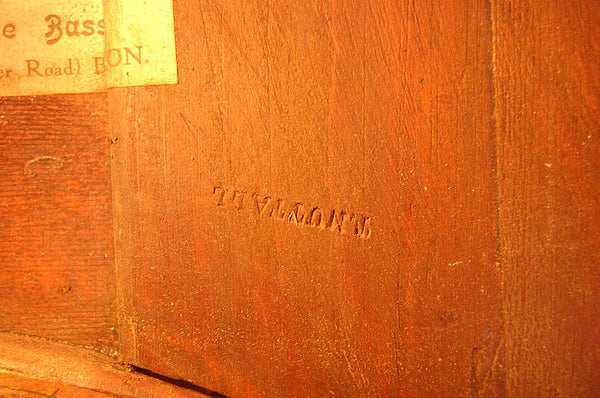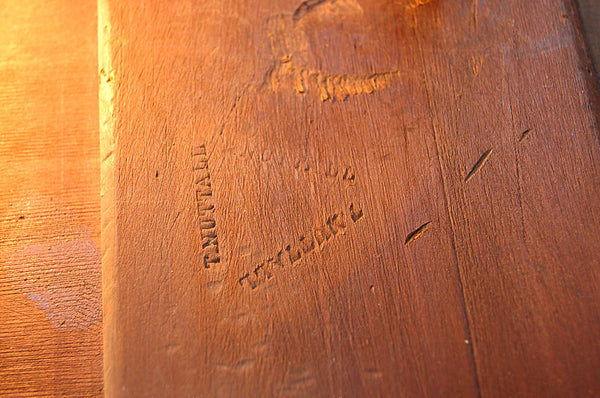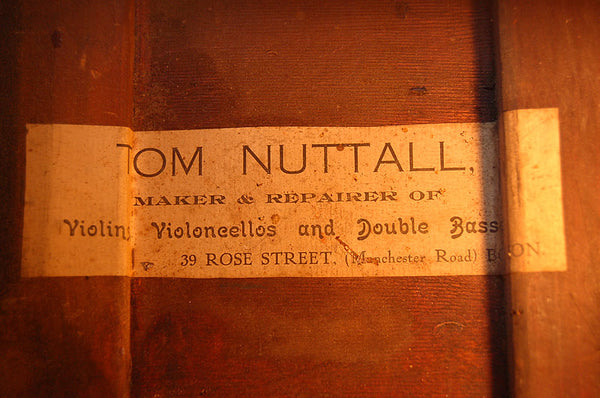
I'm looking for a named English double bass with distinctive looks and a strong punchy sort of sound. What have you got?
You definitely must come and try this great looking instrument by Tom Nuttall. It ticks all of the boxes you mention and many more.
How do you know that the instrument was made by Tom Nuttall?
The instrument bears the maker's original label on the bass side of the inside back.
In size the label measures approximately 22cm in length and 4cm across.
Would you say that the label is quite large?
Yes - it is long enough to partially cover the central brace and cover half the lower of two upper braces.
What does the label say?
The label is printed in black ink and states,
'TOM NUTTALL
MAKER & REPAIRER OF, Violins, Violoncellos and Double Basses
39 ROSE STREET (Manchester Road) BOLTON.'
Are there any other maker's marks?
Yes - the instrument is branded 'T. NUTTALL' in no less than four places on the central brace. One of the brands is located close to the label - the other three are positioned towards the middle of the back brace and form a triangle with the letters facing inwards.
The instrument isn't a typical Northern English model and the label says that he was a repairer. How do you know that Nuttall didn't just repair the instrument?
Good question. The answer is because all the original materials and quality of work on the inside are consistent with the same hand.


What do you mean about the materials?
Most instrument makers use spruce or willow for the internal blocks, linings and braces. On this instrument the central brace, the one immediately above it, the bottom block and all the linings are made from a hard wood - possibly mahogany.
Wow that is quite unusual. I'll bet that Nuttall had a bit of a job to bend the linings.
Yes - the linings are made from three strips of mahogany glued together to form a sort of laminate. The work certainly isn't the neatest or the lightest that we have ever seen.
Does the slightly heavy internal work and use of mahogany suggest that Nuttall may have been a furniture or cabinet maker before starting to make instruments?
It is certainly a good line of thought.
Have you seen any other instruments made by Tom Nuttall?
We have seen images of a violin that bears a near identical label and is stamped with his brand on both the upper and lower outer back. This instrument is dated 1921 and is numbered 33.
Do you have any information on Tom Nuttall?
Unfortunately Nuttall isn't recorded in any of our violin maker dictionaries or reference books.
Did you do any more research?
We have already established that Nuttall made a violin in 1921. What we really wanted to try and find out is how long he had been making instruments by that time. With a view to try and establish his date of birth we took the liberty of looking into some registers for the county of Lancashire.
Did you find anything in the registers?
The baptism records for the Wesleyan Methodist Church, Egerton Street, Farnworh, Lancashire show that a Tom Nuttall was born on the 16th May 1876 and that he was baptised at the church on 20th Jan 1877. His parents were James & Sarah Nuttall who lived at Spring Cottage, Moses Gate, Farnworth.
Is Farnworth a suburb of Bolton?
Yes - it is about 7 miles south of Bolton's town centre.
How can you be so sure that this is the correct Tom Nuttall?
In the marriage records for the town of Bolton it is recorded that on the 11th April 1925 an Emma Nuttall aged 26 got married to a William Hughes aged 27 at the Holy Trinity Church, Bolton, Lancashire. The records show that both Emma and William lived at 39 Rose Street and that the bride's father was Thomas Nuttall - a musician.
So Tom Nuttall was 23 when his daughter was born?
Yes correct. The dates and addresses all tie in nicely.
Feedback from Edward G Hellewell - a retired bass player and amateur genealogist.
Email 1:
"Dear Tony
I always enjoy reading your excellent research and scholarship on basses and their makers - long may it continue. Over the years I've learned so much.
Your recent piece on Tom Nuttall had me thinking. I've been active in genealogical research for 50 years and I took a quick look at the Civil Registration Index (Births) and discovered that there were 182 of that name whose births were registered in Lancashire between 1860 and 1880 (the most likely period of his birth) and of these 24 were in the Bolton Registration District. As a further check I also looked at the 1881 census for Lancashire and found 50 Thomas Nuttalls under the age of 20 and of these 13 were living in the Bolton Registration District. I simply wonder how you managed to confirm that the one whose baptism in 1877 at Farnworth was the correct one? Incidentally, there were two Rose Streets, one in Farnworth which only went to No.30 and one in Bolton which did include No.39.
Kind regards
Ted Hellewell."
Email 2:
"Hi Tony
Tom Nuttall's family history has had me intrigued and I've put in a fair amount of time into this detective work with some surprising findings. I'm now certain that he was not the one you thought was baptised at Farnworth in 1877. The good news, I'm absolutely certain I've got his correct history.
Your information on the marriage of his daughter Emma in 1925 at the age of 25 was the vital clue. Assuming that she gave her correct age at marriage (I've found over the years that many women did not - usually making themselves out to be younger than they actually were!) she must have been born in 1898/9. I first searched the Civil Registration Index for her birth and sure enough found her in the Bolton Registration District in 1898. I then searched the 1901 census when she would be 2 years old. Spot on, I found her living at 10 Scarborough Road, Bolton with her father Thomas Nuttall aged 40, a picture frame maker, born Manchester, her mother Emma aged 41, born Bolton and 6 siblings. Importantly, Thomas must have been born in 1860/1.
Search in the Civ. Reg. Index for births confirmed Thomas's birth registered in the Manchester Reg. Dist. in the 1st quarter 1861.
As a check, I also picked up the family in the 1911 census now living at 104 Bury New Road, Bolton. Thomas gives his occupation once again as a picture frame maker and all other details with regard to ages etc are consistent with the 1901 census. The other bit of useful information on the 1911 is the statement that Thomas and Emma have been married 29 years. Therefore they were married in 1881/2. Of course, it doesn't give Thomas's wife Emma's maiden name.
Using the Civ. Reg. Index for marriages I find that Thomas married in Bolton Reg. Dist. in the 2nd quarter of 1882. Using an amazing bit of trickery I discovered that his wife was formerly Emma Sadler. I haven't followed Emma's family history.
Who were Thomas's parents and had they any musical instrument connections? To answer this I first searched Lancashire parish register baptisms knowing his birth had been registered in Manchester in 1861. I found his baptism at Manchester Cathedral on 17th March 1861. His parents were Henry and Elizabeth Nuttall.
I then turned to the 1881 census searching for Thomas Nuttall aged 20. I discovered him living at 121 Deansgate, Bolton with father Henry, aged 46, tripe dealer, born Manchester and mother Elizabeth, aged 48, born Manchester along with 3 siblings. Thomas gave his occupation as a picture frame maker. A cousin, 14 year old Samuel Bowden was also staying with the family - of relevance in determining identity of Thomas's mother Elizabeth (see next paragraph).
Who was Thomas's mother? From the 1811 census, Thomas, aged 20 was the oldest child listed, born in 1861. A search back from this date in the Civ. Reg. Marriages showed a Henry Nuttall married in Manchester in the 3rd quarter 1858. A second application of trickery produced the name of his spouse as Elizabeth Bowden. This is certainly the one being sought since a Samuel Bowden, cousin of Thomas, was staying with the family in the 1881 census.
Both of Tom Nuttall's parents were from Manchester. I haven't had time to research further back at this stage, but thought you might like the findings to date.
It would seem at this stage that Thomas's family didn't have a musical instrument making tradition. However, his occupation as a picture frame maker would be ideal to take up the trade since he was obviously skilled in wood working and handling planes, chisels etc - think of intricate baroque style carved frames. I guess he must have started as an amateur part-timer much like many others e.g. the two Wakefield makers, James Wm Briggs who was a commercial traveller and bootmaker James Brown (originally from Wakefield before moving to Huddersfield). Of course, details of the 1921 census have not been released - that will show whether Tom Nuttall listed his occupation then as a violin maker or some such.
When I get a bit more time I'll try and take his family history a bit further back and update you.
Kind regards
Ted Hellewell."
Wow - Mr Hellewell must have spent a fair amount of time and effort on this research.
Yes - a big thank you is due to Mr Hellewell for all his interest, time, effort and commitment.
You mentioned a little earlier that the model is very distinctive. What are your thoughts on that?
I would have to say that the characteristics that we tend to associate with Northern English instruments are present in this instrument - it is just that they are a little more disguised than we are used to seeing.
What do you mean disguised?
Well to start with the model is viol shaped and has the flat back with angle break as we would expect from a Northern English maker. What tends to confuse our eyes is the sort of squashed outline and squareish lines - particularly in the centre bouts of the instrument.
What else would you say is a bit different?
We have already mentioned that the wood used internally is a little unconventional.
If you take a look at the wood that Nuttall has used for the front of this instrument you will see that it has been cut on the "quarter" so that the grain is shown as wide circular or elliptical lines rather than narrow vertical lines.
Is that unusual for a Northern English maker?
Yes - this sort of wood selection would be pretty unusual for any nineteenth or twentieth English maker.
Would you say that the F-holes are distinctive too?
Yes - they are certainly nice and generous in their width and in the size of the lobes. There is something English about them but at the same time there isn't an English feel about them - if you know what I mean.
Maybe Nuttall saw something Italian and decided to copy its characteristics.
Yes - this is quite possible.
Was the instrument in good condition when you purchased it?
Apart from the fact that the upper part of the back - from the angle break upwards was missing - not too bad.
What work did you do on the inside of the instrument?
Internally both the upper and lower back braces have been replaced and any cracks have been washed out and restudded.
The neck looks nicely flamed. Is that new?
Yes. New "D" neck and fingerboard and first class set up.
What else will I like about the instrument?
The small string length which measures only 105.1cm.
Final Words.
Wherever the inspiration came from to make this subtle and distinctive instrument Tom Nuttall did a pretty decent job of adopting and adapting it into his own unique and individual style.
Final, final words.
This really is a charming instrument with Italianesque looks and a positive punchy type of sound. If you are hoping to create a very special sort of image for yourself this could well be the perfect partner for you.

